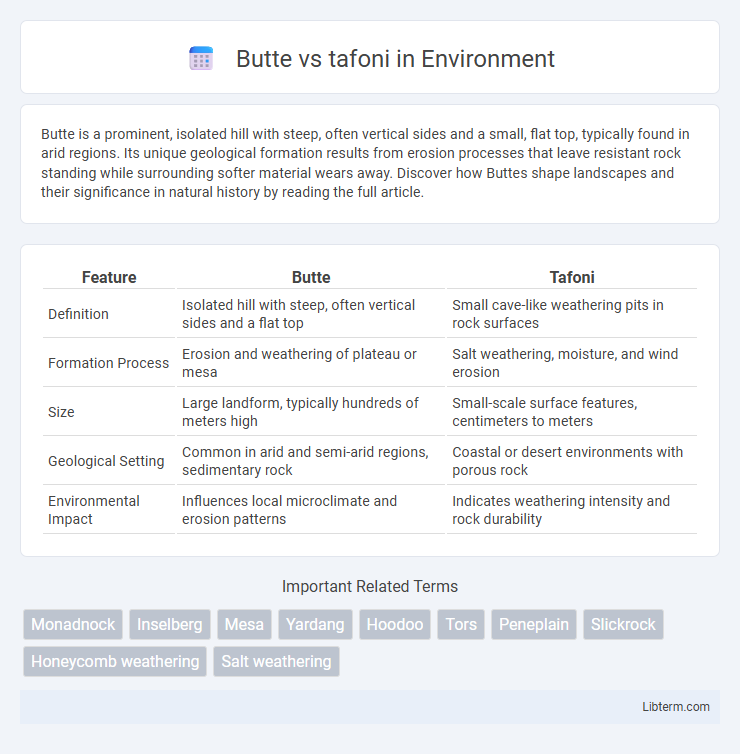Butte is a prominent, isolated hill with steep, often vertical sides and a small, flat top, typically found in arid regions. Its unique geological formation results from erosion processes that leave resistant rock standing while surrounding softer material wears away. Discover how Buttes shape landscapes and their significance in natural history by reading the full article.
Table of Comparison
| Feature | Butte | Tafoni |
|---|---|---|
| Definition | Isolated hill with steep, often vertical sides and a flat top | Small cave-like weathering pits in rock surfaces |
| Formation Process | Erosion and weathering of plateau or mesa | Salt weathering, moisture, and wind erosion |
| Size | Large landform, typically hundreds of meters high | Small-scale surface features, centimeters to meters |
| Geological Setting | Common in arid and semi-arid regions, sedimentary rock | Coastal or desert environments with porous rock |
| Environmental Impact | Influences local microclimate and erosion patterns | Indicates weathering intensity and rock durability |
Introduction to Buttes and Tafoni
Buttes are isolated hills with steep, often vertical sides and a flat top, typically formed through erosion in arid landscapes, prominently seen in regions like the American Southwest. Tafoni are small, cavernous rock features characterized by honeycomb-like weathering patterns, commonly found on coastal cliffs and desert rock surfaces caused by salt weathering and moisture cycles. Understanding the formation and distinguishing characteristics of buttes and tafoni is essential in geomorphology and rock weathering studies.
Geological Definitions: Butte vs Tafoni
A butte is a prominent isolated hill with steep, often vertical sides and a small, flat top, formed primarily through erosion processes acting on rock layers. Tafoni are small cave-like features or hollows found in granular rock, created by weathering mechanisms like salt crystallization and moisture erosion. These geological formations differ significantly in scale and origin: buttes represent large erosional remnants, whereas tafoni are localized weathering features on rock surfaces.
Formation Processes of Buttes
Buttes form through differential erosion, where resistant rock layers cap softer strata that erode more quickly under wind and water exposure. Over time, vertical joints and fractures facilitate weathering, isolating steep-sided, flat-topped hills. Unlike tafoni, which develop from granular disintegration and salt crystallization on rock surfaces, buttes result primarily from large-scale erosional forces shaping prominent landforms.
Tafoni: Origin and Development
Tafoni are small cave-like features commonly found in coastal and desert environments, formed through salt weathering and moisture cycling that prolongs rock disintegration. Their origin involves chemical and physical processes where salt crystals grow in rock pores, exerting pressure that gradually enlarges hollows over time. These distinctive honeycomb patterns develop predominantly on granular rocks like sandstone and granite, reflecting environmental influences such as wind, moisture, and salt spray.
Environmental Factors Influencing Buttes and Tafoni
Buttes typically form through differential erosion in arid and semi-arid climates where water and wind selectively wear away softer rock layers, leaving resistant rock standing prominently. Tafoni develop mainly in coastal and desert environments where salt weathering, moisture fluctuations, and temperature extremes cause granular disintegration and cavity formation in porous rock surfaces. Both landforms reflect the interplay of climatic conditions, rock type, and weathering processes unique to their environmental settings.
Key Differences Between Butte and Tafoni
Buttes are isolated, steep-sided hills with a flat top formed primarily through erosion of plateaus, whereas tafoni are small, cavity-like rock formations created by weathering processes such as salt crystallization and moisture fluctuations. Buttes are prominent landscape features often found in arid regions and can rise hundreds of feet above the surrounding terrain, while tafoni typically occur on rock surfaces and range from a few centimeters to several meters in size. The key difference lies in their scale and formation: buttes are large geomorphological landforms shaped by erosion, while tafoni are micro-scale surface textures resulting from chemical and physical weathering.
Notable Global Examples of Buttes
Buttes are isolated hills with steep, often vertical sides and a small, flat top, commonly found in arid regions, with notable global examples including Devils Tower in Wyoming, USA, and The Monument in Australia. These landforms contrast with tafoni, which are small to medium-sized cavities or pits formed in granular rock like sandstone or granite through weathering processes. Buttes serve as prominent geological landmarks representing erosional remnants, while tafoni highlight intricate weathering patterns on rock surfaces.
Famous Locations Featuring Tafoni
Famous locations featuring tafoni include the iconic sandstone formations of the Meteora region in Greece, known for their weathered cavities and honeycomb textures. In the United States, tafoni are prominently found in the coastal sandstone cliffs of Point Lobos State Natural Reserve in California and the deserts of the southwestern states like Utah and Arizona. These natural sculptures provide valuable insights into geological weathering processes and attract numerous geologists and tourists worldwide.
Ecological and Cultural Significance
Buttes serve as important ecological niches supporting diverse plant and animal species adapted to arid environments, while tafoni formations provide microhabitats that conserve moisture and shelter small organisms in harsh climates. These geological features hold cultural significance for indigenous communities, symbolizing sacred landmarks and inspiring traditional stories, rituals, and art. Understanding their ecological roles and cultural meanings promotes conservation efforts that preserve both natural biodiversity and cultural heritage.
Comparing Butte and Tafoni: Summary and Insights
Buttes are isolated hill formations with steep, often vertical sides and a flat top, resulting from resistant rock layers that withstand erosion. Tafoni are small to large cavernous rock weathering features characterized by hollowed-out surfaces, typically found in granular rock such as sandstone or granite. While buttes represent large-scale erosional remnants shaping regional landscapes, tafoni illustrate micro-scale weathering processes that modify rock surfaces, making them complementary features in geomorphology studies.
Butte Infographic

 libterm.com
libterm.com